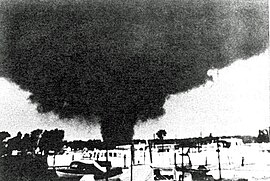Flint–Worcester tornado outbreak sequence

|
|
| Type | Tornado outbreak |
|---|---|
| Duration | June 7–9, 1953 |
| Tornadoes confirmed | 46 |
| Max rating1 | F5 tornado |
| Duration of tornado outbreak2 | 3 days |
| Damage | $2.56 billion (2006 USD) |
| Casualties | 245 fatalities, Unknown amount of injuries |
| Areas affected | Midwestern and Northeastern United States |
|
1Most severe tornado damage; see Fujita scale 2Time from first tornado to last tornado |
|
1Most severe tornado damage; see Fujita scale
The 1953 Flint–Worcester tornado outbreak sequence was a devastating tornado outbreak sequence spanning three days, two of which featured tornadoes each causing at least 90 deaths—an F5 occurring in Flint, Michigan, on June 8, 1953, and an F4 in Worcester, Massachusetts, on June 9. These tornadoes are among the deadliest in United States history and were caused by the same storm system that moved eastward across the nation. The tornadoes are also related together in the public mind because, for a brief period following the Worcester tornado, it was debated in the U.S. Congress whether recent atomic bomb testing in the upper atmosphere had caused the tornadoes. Congressman James E. Van Zandt (R-Penn.) was among several members of Congress who expressed their belief that the June 4th bomb testing created the tornadoes, which occurred far outside the traditional tornado alley. They demanded a response from the government. Meteorologists quickly dispelled such an assertion, and Congressman Van Zandt later retracted his statement.
The Flint-Worcester Tornadoes were the most infamous storms produced by a larger outbreak of severe weather that began in Nebraska, Iowa and Wisconsin, before moving across the Great Lakes states, and then into New York and New England. Other F3 and F4 tornadoes struck other locations in Massachusetts, Michigan, New Hampshire and Ohio.
This chart shows the number of tornadoes spawned from the initial storm system.
An F5 tornado hit Flint, Michigan on June 8, 1953. The tornado moved east-northeast 2 miles (3.2 km) north of Flushing and devastated the north side of Flint and Beecher. The tornado first descended about 8:30 p.m. on a humid evening near a drive-in movie theater that was flickering to life at twilight time. Motorists in the drive-in began to flee in panic, creating many auto accidents on nearby roads. The tornado dissipated near Lapeer, Michigan. Nearly every home was destroyed on both sides of Coldwater Road. Multiple deaths were reported in 20 families, and it was reported that papers from Flint were deposited in Sarnia, Ontario, Canada, some sixty miles east of Flint. Large sections of neighborhoods were completely swept away, with only foundations left. Trees were debarked and vehicles were thrown and mangled. One hundred and sixteen were killed, making it the tenth deadliest tornado in U.S. history. The death toll was surpassed by the 2011 Joplin tornado. It is also one of only two F5 tornadoes ever to hit in Michigan. Another F5 would hit in Hudsonville on April 3, 1956.
...
Wikipedia
